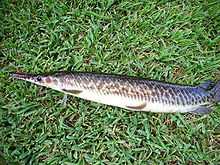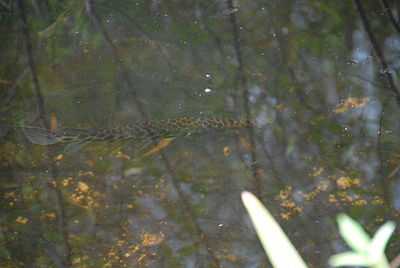Florida gar
| Florida gar | |
|---|---|
 | |
| Scientific classification | |
| Kingdom: | Animalia |
| Phylum: | Chordata |
| Class: | Actinopterygii |
| Order: | Lepisosteiformes |
| Family: | Lepisosteidae |
| Genus: | Lepisosteus |
| Species: | L. platyrhincus |
| Binomial name | |
| Lepisosteus platyrhincus DeKay, 1842 | |
The Florida gar (Lepisosteus platyrhincus) is a species of gar found in the USA from the Savannah River and Ochlockonee River watersheds of Georgia and throughout peninsular Florida. Florida gars can reach a length of over 3 ft (132 cm). The young feed on zooplankton and insect larvae, as well as small fish. Adults mainly eat fish, shrimp, and crayfish. Although edible, they are not popular as food. The roe is highly toxic to many animals, including humans and birds. Gar are mentioned in the John Anderson song "Seminole Wind".
Appearance
This is a mid-sized species of gar. It measures from 51.7 to 132.2 cm (20.4 to 52.0 in) long and typically weighs 1.36 to 4.36 kg (3.0 to 9.6 lb).[1] According to the IGFA, the record weight for this species is 10 kg (22 lb).[2] This species has irregular round, black spots on the top of its head and over the entire body including the anal fin. The distance of the eyes is less than two-thirds the length of the snout. Also, it has a shorter, broad snout with a single row of irregularly spaced sharp teeth on the upper and lower jaws. No bony scales are on the throat. Their color is olive-brown on the back and upper sides, with a white to yellow belly. The young may have dark stripes on the back and sides.
Environment
They can be found in the Ochlockonee River and waters east and in peninsular Florida in medium to large lowland streams, canals, and lakes with muddy or sandy bottoms near underwater vegetation. They are often found in medium to shallow waters. They use an air bladder to breathe air which helps them survive in poorly oxygenated water.
Reproduction
This occurs in late winter and early spring. Groups of both sexes come together in shallow, weedy water where the females discharge their adhesive eggs among the aquatic plants. The hatched young possess an adhesive organ on the end of their snouts and stay attached to vegetation until about 0.8 in (2 cm) long.
See also
List of fish species in Florida
References
- Froese, Rainer and Pauly, Daniel, eds. (2009). "Lepisosteus platyrhincus" in FishBase. 02 2009 version.
